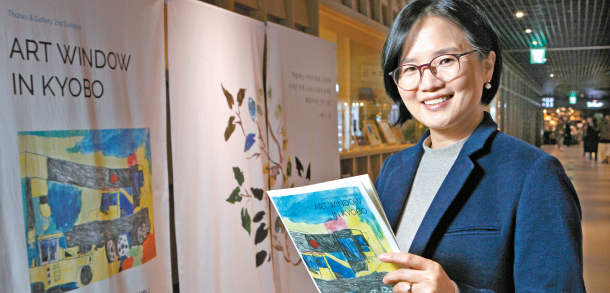Children with disabilities reveal talent at art show

CEO Kim Nan-hee of social start-up Thanks&Company poses in front of the exhibit “Art Window in Kyobo” at the Kyobo Bookstore in Hapjeong-dong, western Seoul. The art exhibition’s pieces were made by children with developmental disabilities. [PARK SANG-MOON]
The pieces in the exhibit “Art Window in Kyobo” were created by young students, and each have its own distinctive style. The animal croquis on the wall were drawn with a thick calligraphy brush. Two of the works are detailed pencil drawings of train stations and railways.
“Our most popular artist in this exhibition is seven-year-old Kim Seo-joon. He never received formal art education before, but he draws landscapes on various canvases, from sketch books to the backside of a jigsaw puzzle,” said Kim Nan-hee, the CEO of Thanks&Company, which organized the exhibition, on Friday. “His parents seem to be offering him a wide range of ingredients to play with.”
Thanks&Company is a social start-up that organizes art exhibitions of work made by children with developmental disabilities. Originally a book publisher, Kim didn’t have any prior experience in art at all until a year ago.
The start of Kim’s journey into art was a one-day festival held at Sungmisan School, an alternative school that her 11-year-old son attends in Mapo District, western Seoul.
“He told me he wanted to do something at the festival, so I suggested an art exhibition with his friends,” said Kim. Her son, who also has a developmental disability, has painted animals and human movement using charcoal and calligraphy brushes for the past 10 years.
In June, she started Thanks&Company after being accepted to an incubation program offered by the state-funded Korea Social Enterprise Promotion Agency.
“I asked other parents to join in and bring any kind of work from home and [told them] that I would pay for the frames. It was a huge success. The kids were so happy and so were the parents. That’s when I started thinking that I wanted the exhibition to last longer than a day.”
Some suggested a subway station as the next venue, as they frequently present artwork from students. Kim firmly said no. She wanted the children’s work to be hung somewhere more proper, where the artists’ friends can see them and be in awe of them. As a publisher, Kim turned to public libraries and bookstores.
The first exhibition place was the public library in Mapo District. Every venue is close to the children’s homes, so friends and classmates can easily come see the artwork.
“Among the children who participated that day was a boy named Lee Do-eun. He frequently doodles on his classmates’ notebooks, which became a problem,” said Kim. “It happened again after the exhibition, but this time, his friends were not only welcoming but wanted to receive his autograph.”
The exhibition resulted in important milestones for many children that took part in it. One nine-year-old said “thank you very much” for the first time to visitors, and a seven-year-old revealed to his mother that he wants to become an artist when he grows up.
For Kim, these stories increased her confidence in the project.
Not every child with a developmental disability loves art, Kim said, but many of those do can easily fill dozens of sheets of paper with just a single day’s work. Their themes and tools are often fixed, creating a unique style of art for each individual.
“One child that participated in the Kyobo exhibition only paints train stations and railways,” said Kim. “Kids like him, who have drawn for years, are instantly recognizable in their work and how they use their pencils.”
Thirteen of the works exhibited by the company were sold. Two of them were shown at this year’s Union Art Fair, a renowned annual event among Korean artists. All proceeds from the sales are given to the artists. Thanks&Company also sells products such as mugs, key chains and silk scarfs based on the works, and 7 percent of the revenues are given to the artists as copyright fees. Starting next year, Kim plans to knock on company doors to sell these products in bulk.
Thanks&Company’s exhibition at Kyobo also featured an adult guest artist. But Kim’s aim is not necessarily to develop children into artists.
These children often have difficulty expressing themselves with words, and for her, giving them another way of communicating with the world and their parents is what’s most meaningful.
“The ultimate goal of our exhibitions is to develop pride in our children. As long as that’s fulfilled, I don’t think it’s important to push them to necessarily be anything when they grow up,” she said.
BY SONG KYOUNG-SON [song.kyoungson@joongang.co.kr ]










with the Korea JoongAng Daily
To write comments, please log in to one of the accounts.
Standards Board Policy (0/250자)